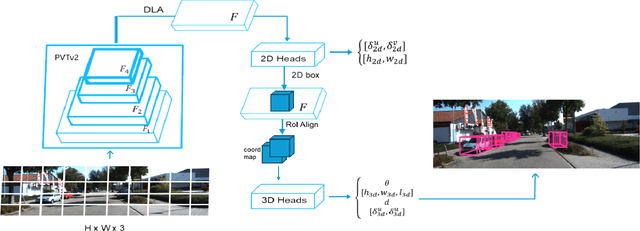Yangxintong Lyu
HybridTrack: A Hybrid Approach for Robust Multi-Object Tracking
Jan 02, 2025



Abstract:The evolution of Advanced Driver Assistance Systems (ADAS) has increased the need for robust and generalizable algorithms for multi-object tracking. Traditional statistical model-based tracking methods rely on predefined motion models and assumptions about system noise distributions. Although computationally efficient, they often lack adaptability to varying traffic scenarios and require extensive manual design and parameter tuning. To address these issues, we propose a novel 3D multi-object tracking approach for vehicles, HybridTrack, which integrates a data-driven Kalman Filter (KF) within a tracking-by-detection paradigm. In particular, it learns the transition residual and Kalman gain directly from data, which eliminates the need for manual motion and stochastic parameter modeling. Validated on the real-world KITTI dataset, HybridTrack achieves 82.08% HOTA accuracy, significantly outperforming state-of-the-art methods. We also evaluate our method under different configurations, achieving the fastest processing speed of 112 FPS. Consequently, HybridTrack eliminates the dependency on scene-specific designs while improving performance and maintaining real-time efficiency. The code will be publicly available at the time of publishing: https://github.com/leandro-svg/HybridTrack.git.
Strada-LLM: Graph LLM for traffic prediction
Oct 28, 2024



Abstract:Traffic prediction is a vital component of intelligent transportation systems. By reasoning about traffic patterns in both the spatial and temporal dimensions, accurate and interpretable predictions can be provided. A considerable challenge in traffic prediction lies in handling the diverse data distributions caused by vastly different traffic conditions occurring at different locations. LLMs have been a dominant solution due to their remarkable capacity to adapt to new datasets with very few labeled data samples, i.e., few-shot adaptability. However, existing forecasting techniques mainly focus on extracting local graph information and forming a text-like prompt, leaving LLM- based traffic prediction an open problem. This work presents a probabilistic LLM for traffic forecasting with three highlights. We propose a graph-aware LLM for traffic prediction that considers proximal traffic information. Specifically, by considering the traffic of neighboring nodes as covariates, our model outperforms the corresponding time-series LLM. Furthermore, we adopt a lightweight approach for efficient domain adaptation when facing new data distributions in few-shot fashion. The comparative experiment demonstrates the proposed method outperforms the state-of-the-art LLM-based methods and the traditional GNN- based supervised approaches. Furthermore, Strada-LLM can be easily adapted to different LLM backbones without a noticeable performance drop.
LAM3D: Leveraging Attention for Monocular 3D Object Detection
Aug 03, 2024



Abstract:Since the introduction of the self-attention mechanism and the adoption of the Transformer architecture for Computer Vision tasks, the Vision Transformer-based architectures gained a lot of popularity in the field, being used for tasks such as image classification, object detection and image segmentation. However, efficiently leveraging the attention mechanism in vision transformers for the Monocular 3D Object Detection task remains an open question. In this paper, we present LAM3D, a framework that Leverages self-Attention mechanism for Monocular 3D object Detection. To do so, the proposed method is built upon a Pyramid Vision Transformer v2 (PVTv2) as feature extraction backbone and 2D/3D detection machinery. We evaluate the proposed method on the KITTI 3D Object Detection Benchmark, proving the applicability of the proposed solution in the autonomous driving domain and outperforming reference methods. Moreover, due to the usage of self-attention, LAM3D is able to systematically outperform the equivalent architecture that does not employ self-attention.
DeepKalPose: An Enhanced Deep-Learning Kalman Filter for Temporally Consistent Monocular Vehicle Pose Estimation
Apr 25, 2024



Abstract:This paper presents DeepKalPose, a novel approach for enhancing temporal consistency in monocular vehicle pose estimation applied on video through a deep-learning-based Kalman Filter. By integrating a Bi-directional Kalman filter strategy utilizing forward and backward time-series processing, combined with a learnable motion model to represent complex motion patterns, our method significantly improves pose accuracy and robustness across various conditions, particularly for occluded or distant vehicles. Experimental validation on the KITTI dataset confirms that DeepKalPose outperforms existing methods in both pose accuracy and temporal consistency.
* 4 pages, 3 Figures, published to IET Electronic Letters
 Add to Chrome
Add to Chrome Add to Firefox
Add to Firefox Add to Edge
Add to Edge